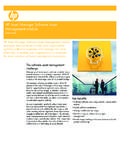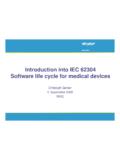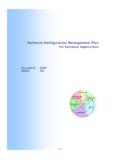Transcription of Software Acquisition & Supplier Management: …
1 Software Acquisition & Supplier management : part 1 Product Definition & Supplier Selection Theresa Hunt Senior Consultant The Westfall Team Orlando, FL 32750 Linda Westfall President The Westfall Team Plano, TX 75075 SUMMARY Today s Software intensive products and business practices require companies to approach Software purchases with a well-informed and strategic method. This paper discusses the first seven steps in the Software Acquisition and Supplier management Model illustrated in figure 1, including: Step 1: Planning the Acquisition Step 2: Defining the Software product s requirements Step 3: Determining the Acquisition approach Step 4: Identifying and evaluating potential suppliers (and their Software products) Step 5: Defining the contract requirements Step 6: Selecting a Supplier Step 7: Negotiating and awarding the contract Figure 1 - Software Acquisition and Supplier management Model INTRODUCTION Before the task of purchasing commercially available Software , contracting a Supplier to create a custom Software package, or developing a homegrown Software application can commence, adequate planning must take place.
2 Having a defined Software Acquisition and Supplier management process helps insure that important steps in the Acquisition process are not forgotten. Predefined goals and objectives align the business needs with the mission of the Acquisition . The Software Plan the AcquisitionDefine the Software ProductDefine the Software ProductDetermine Acquisition ApproachDetermine Acquisition ApproachDetermine Acquisition ApproachNegotiate & Award ContractNegotiate & Award ContractSelect a SupplierSelect a SupplierManage SupplierManage SupplierAccept Product & Close ContractAccept Product & Close ContractSoftware DevelopmentBuildIdentify & Evaluate Potential SuppliersDefine Contract RequirementsBuyindustry is now several decades old, however problems including schedule slippage, budget overruns, missing functionality and poor quality and reliability are still prevalent. These continuing issues make the need for good Software Acquisition and Supplier management practices essential to the success of our organizations.
3 Those who cannot remember the past are condemned to repeat it. George Santayana. [Santayana-05] The reason we keep making the same mistakes over and over is that we are not learning from our own past. We either fail to examine the past because we are afraid of what we will find, we make an assumption that the past is not relevant because this project is different , or we don t have the mechanisms in place to capture the data and information we need to adequately analyze our past efforts. However, as Software becomes an integral part of our businesses and our lives, we can no longer afford not to learn from our past mistakes. Having a defined Software Acquisition and Supplier management process facilitates the propagation of lessons learned from one Acquisition project to the next so we can repeat our successes and stop repeating actions that lead to problems. STEP 1 - PLAN THE Acquisition Planning for the Software Acquisition begins when the idea or need is established for acquiring a Software product.
4 In this first step of the Acquisition process: Key Acquisition roles are assigned The business need for the Software is described in terms of technical and functional needs, quality attributes, project constraints, and acceptance and completion criteria The Acquisition plan is documented Assigning Key Roles: Responsibilities for key Acquisition roles must be assigned. This includes the Acquisition sponsor, Acquisition manager and members of the Acquisition team. It also includes representatives from the customer and/or user community and other key stakeholders that will work with the Acquisition team to define the business needs and Software requirements. The role of the Acquisition sponsor is to provide organizational influence to help justify and sell the Acquisition within the acquirer s organization. The sponsor is responsible for: Communicating the vision of the proposed product to executive management Establishing credibility to the Acquisition effort Obtaining approval to proceed Supplying a solid business case and strong support for the Acquisition Championing the cause of the Acquisition Ensuring ongoing funding, staffing and resources for the Acquisition project The role of the Acquisition manager is to: Lead and manage the Acquisition team Direct ongoing Acquisition project activities Control cost and schedule Track and control the Acquisition project against the plan Report Acquisition status to the sponsor and other management The role of each individual Acquisition Team member is to adequately represent their stakeholder organization and to perform assigned tasks.
5 Describe the Business Need: The increasingly high rate of change in new technology makes it difficult for companies to keep up with current trends and remain competitive. The current state of the company has to be continually examined to determine any need for change or update. A business need could be a problem that needs to be addressed or it could be an opportunity for the business to improve in some area. It is important to precisely specify the business need so that people will clearly understand what action is to be taken and avoid addressing the wrong need. Quantitative measures consisting of data related to the stated business need should be used to support the facts upon which the need is based. For example, the need to obtain a Software configuration management tool could be supported with quantitative measures including the number of source modules, lines of code, fielded and in-process versions of the Software that must be maintained.
6 The business need also includes the description of any assumptions upon which the project is based or any constraints on the project factors such as schedule, budget, resources, Software to be reused, acquired Software to be incorporated, technology to be employed, and product interfaces to other products. For example, any estimates, expectations, statements or proposed solutions that lack supporting data should be considered as assumptions. Business sponsors and stakeholders indicate their buy-in and support of the business need through the approval of the business need description. The identity of the stakeholders is not always obvious. Different stakeholders can also give conflicting direction. This is especially difficult if one organization is paying for the Software and another is going to actually use it and they disagree about the basic business need. Despite all of these difficulties, agreement needs to be reached about what the Software will do.
7 The Acquisition Team must understand the individual stakeholder motives. How might the stakeholders benefit from the Acquisition and how might the Acquisition be a threat to them? A recommended method for accomplishing this is to meet with each stakeholder individually to encourage open communication and sharing of both positive and negative perspectives of the Acquisition as it relates to them. Stakeholders typically have commonly acknowledged business needs that the Acquisition Team can easily identify. However, stakeholders may also have unacknowledged motives (hidden agendas) that might drive the direction of their influence on the Acquisition effort. The Acquisition Team needs to uncover and understand both the acknowledged business needs and these less obvious motives to effectively plan the Acquisition . Table 1 includes an example of business needs/motives for the Acquisition of a payroll Software package: Table 1 Example of Business Needs/Motives for a Payroll Software Package Acquisition Key Stakeholder Business Needs/Motives Accounting Convenient mechanisms for capturing time worked, vacations, etc.
8 For each employee Track, reconcile, manage and report payroll Eliminate the need to chase employees and supervisors for completed/ approved timesheets each pay period Keep jobs (don t automate people out of employment) HR Automate and track employee elected deductions, contributions, savings, etc. Eliminate the tedious tasks of dealing with paper forms from their workload Employees Convenient mechanisms for reporting time worked, vacations, etc. Detailed statement of earnings, deductions, contributions, savings, etc. On time delivery of accurate paychecks and automatic deposit of payroll check to banks Elimination of many different, complicated (sometimes hard to obtain) forms for requesting/changing deductions, contributions, insurance benefits, savings plans, etc. IRS, Social Security and State Tax Offices Ability to automate wage garnishment, reporting and fund transfers for taxes owed Ability to collect taxes owed on or before due date Eliminate labor intensive paperwork Insurance Companies Ability to automate premium payments through payroll deduction Ability to sell more policies and options to employees Charities Ability to establish and automate long term contributions through payroll deduction Employee s Bank Automated transfer of payroll into employee bank accounts Get entire payroll check into employee bank account sooner Eliminate labor intensive paperwork and need for human interaction with paycheck Company s Bank Automated transfer of payroll into employee bank accounts Automated transfer of withheld taxes from company account Keep company s money in their accounts as long as possible Eliminate labor intensive paperwork and need for human interaction with paycheck Document the Acquisition Plan.
9 An Acquisition Plan is established to detail the methods to be employed throughout the Acquisition project s life cycle. The time spent defining the Acquisition strategy early on will go a long way in assuring stability throughout the Acquisition process and the life of the Software . The Acquisition planning process should link Acquisition objectives and tasks to resources (time, people, funds, and technology). It must organize these resources and define a process for achieving the approval of all stakeholders to guarantee the adoption of the Acquisition plan. It should then guide the Acquisition activities and provide for the integration of the effort. Software Acquisition activities are sensitive to the same risks that occur in any project and require the same level of project and risk planning and management concerning decisions, budget, schedule, quality, etc. STEP 2 - DEFINE THE Software PRODUCT In the Define the Software Product step of the Acquisition process, the Software requirements are elicited, analyzed, specified and validated.
10 This step drives the direction of the Acquisition . The desired product must be adequately analyzed and its individual features and quality attributes decided on and documented. The Acquisition Team should prioritize the requirements and separate needs from wants. Successful Acquisition projects are dependent on clearly defined requirements. We cannot stress enough the importance of good requirements documentation. As identified in a Standish Group survey, IT executive managers believe that the three major reasons that a project will succeed are user involvement, executive management support, and a clear statement of requirements. Opinions about why projects are impaired and ultimately canceled ranked incomplete requirements and lack of user involvement at the top of the list. [Standish-95] In order to write good requirements documentation we need to understand the basic categories of requirements. Requirements are classically referred to in two categories: Functional and Non-Functional requirements and design constraints.





